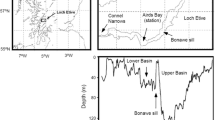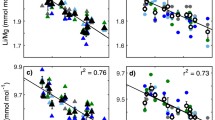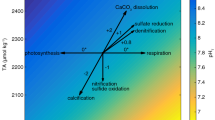Abstract
Water quality and criculation in Florida Bay (a shallow, subtropical estuary in south Florida) are highly dependent upon the development and evolution of carbonate mud banks distributed throughout the Bay. Predicting the effect of natural and anthropogenic perturbations on carbonate sedimentation requires an understanding of annual, seasonal, and daily variations in the biogenic and inorganic processes affecting carbonate sediment precipitation and dissolution. In this study, net calcification rates were measured over diurnal cycles on 27 d during summer and winter from 1999 to 2003 on mud banks and four representative substrate types located within basins between mud banks. Substrate types that were measured in basins include seagrass beds of sparse and intermediate densityThalassia sp., mud bottom, and hard bottom communities. Changes in total alkalinity were used as a proxy for calcification and dissolution. On 22 d (81%), diurnal variation in rates of net calcification was observed. The highest rates of net carbonate sediment production (or lowest rates of net dissolution) generally occurred during daylight hours and ranged from 2.900 to −0.410 g CaCO3 m−2d−1. The lowest rates of carbonate sediment production (or net sediment dissolution) occurred at night and ranged from 0.210 to −1.900 g CaCO3 m−2 night−1. During typical diurnal cycles, dissolution during the night consumed an average of 29% of sediment produced during the day on banks and 68% of sediment produced during the day in basins. Net sediment dissolution also occurred during daylight, but only when there was total cloud cover, high turbidity, or hypersalinity. Diurnal variation in calcification and dissolution in surface waters and surface sediments of Florida Bay is linked to cycling of carbon dioxide through photosynthesis and respiration. Estimation of long-term sediment accumulation rates from diurnal rates of carbonate sediment production measured in this study indicates an overall average accumulation rate for Florida Bay of 8.7 cm 1000 yr−1 and suggests that sediment dissolution plays a more important role than sediment transport in loss of sediment from Florida Bay.
Similar content being viewed by others
Literature Cited
Barnes, D. J. andB. E. Chalker. 1990. Calcification and photosynthesis in reef-building corals and algae, p. 109–131.In Z. Dubinsky (ed.), Ecosystems of the World 25: Coral Reefs. Elsevier, Amsterdam, The Netherlands.
Barnes, D. J. andM. J. Devereux. 1984. Productivity and calcification on a coral reef: A survey using pH and oxygen electrode techniques.Journal of Experimental Marine Biology and Ecology 79:213–231.
Bosence, D. W. J. 1989a. Biogenic carbonate production in Florida Bay.Bulletin of Marine Science 44:419–433.
Bosence, D. W. J. 1989b. Surface sublittoral sediments of Florida Bay.Bulletin of Marine Science 44:434–453.
Bosence, D. W. J. 1989c. Carbonate budgets for carbonate mounds, p. 529–534.In C. Gabrie, J. L. K. Toffart, and B. Salvat (eds.), 6th International Symposium on Coral Reefs, International Society for Reef Studies, Townsville, Australia.
Bosence, D. W. J. 1995. Anatomy of a recent biodetrital mudmound, Florida Bay, USA.Special Publications of the International Association for Sedimentology 23:475–493.
Bosence, D. W. J., R. Rowlands, andM. J. Quine. 1985. Sedimentology and budget of a recent carbonate mound, Florida Keys.Sedimentology 32:317–343.
Boucher, G., J. Clavier, C. Hily, andJ. P. Gattuso. 1998. Contribution of soft-bottoms to the community metabolism (primary production and calcification) of a barrier reef flat (Moorea, French Polynesia).Journal of Experimental Marine Biology and Ecology 225:269–283.
Boyer, J. N., J. W. Fourqurean, andR. D. Jones. 1999. Seasonal and long-term trends in water quality of Florida Bay (1989–1997).Estuaries 22:417–430.
Brewster-Wingard, G. L. andS. E. Ishman. 1999. Historical trends in salinity and substrate in Central Florida Bay: A paleoecological reconstruction using modern analogue data.Estuaries 22: 369–383.
Broecker, W. S. andT. Takahashi. 1966. Calcium carbonate precipitation on the Bahama Banks.Journal of Geophysical Research 71:1575–1602.
Cesar, H. S. J. andP. J. H. van Beukering. 2004. Economic valuation of the coral reefs of Hawaii.Pacific Science 58:231–242.
Chisholm, J. R. M. andJ. P. Gattuso. 1991. Validation of the alkalinity anomaly technique for investigating calcification and photosynthesis in coral reef communities.Limnology and Oceanography 36:1232–1239.
Corbett, D. R., J. Chanton, W. Burnett, K. Dillon, andC. Rutkowski. 1999. Patterns of groundwater discharge into Florida Bay.Limnology and Oceanography 44:1045–1055.
Corbett, D. R., K. Dillon, W. Burnett, andJ. Chanton. 2000. Estimating the groundwater contribution into Florida Bay via natural tracers,222Rn and CH4.Limnology and Oceanography 45:1546–1557.
Dickson, A. G. 1990. Standard potential of the reaction: AgCl(s)+1/2H2(g)=Ag(s)+HCl(aq), and the standard acidity constant of the ion HSO4− in synthetic seawater from 273.15–318.15 K.Journal of Chemical Thermodynamics 22:113–127.
Dickson, A. G., J. D. Afghan, andG. C. Anderson. 2003. Reference materials for oceanic CO2 analysis: A method for the certification of total alkalinity.Marine Chemistry 80:185–197.
Dickson, A. G. andF. J. Millero. 1987. A comparison of the equilibrium constants for the dissociation of carbonic acid in seawater media.Deep-Sea Research 34:1733–1743.
Fourqurean, J. W., R. D. Jones, andJ. C. Zieman. 1995. Processes influencing water column nutrient characteristics and phosphorous limitation of phytoplankton biomass in Florida Bay, FL, USA: Inferences from spatial distributions.Estuarine Coastal and Shelf Science 36:295–314.
Fourqurean, J. W. andM. B. Robblee. 1999. Florida Bay: A history of recent ecological changes.Estuaries 22:345–357.
Frankovich, T. A. andJ. C. Zieman. 1994. Total epiphyte and epiphytic carbonate production onThalassia testudinum across Florida Bay.Bulletin of Marine Science 54:679–695.
Friedlander, A. M. andJ. D. Parrish. 1998. Habitat characteristics affecting fish assemblages on a Hawaiian coral reef.Journal of Experimental Marine Biology and Ecology 224:1–30.
Gattuso, J. P., M. Frankignoulle, andR. Wollast. 1998. Carbon and carbonate metabolism in coastal aquatic ecosystems.Annual Reviews of Ecological Systems 29:405–434.
Gattuso, J. P., C. E. Payri, M. Pichon, B. Delesalle, andM. Frankignoulle. 1997. Primary production, calcification, and air-sea CO2 fluxes of a macroalgal-dominated coral reef community (Moorea, French Polynesia).Journal of Phycology 33:729–738.
Gattuso, J. P., M. Pichon, B. Delesalle, andM. Frankignoulle. 1993. Community metabolism and air-sea CO2 fluxes in a coral reef ecosystem (Moorea, French Polynesia).Marine Ecology Progress Series 96:259–267.
Ginsburg, R. N. 1979. In P. Enos and R. Perkins (eds.), Evolution of Florida Bay from island stratigraphy.Geological Society of America Bulletin 90:59–83.
Halley, R. B. andL. M. Roulier. 1999. Reconstructing the history of Eastern and Central Florida Bay using mollusk-shell isotope records.Estuaries 22:358–368.
Halley, R. B., K. K. Yates, and C. H. Holmes. 2001. Sea-level rise and the future of Florida Bay in the next century, p. 103–104.In U.S. Geological Survey Program on the South Florida Ecosystem: 2000 Proceedings. U.S. Geological Survey Open-File Report 00-449. Washington, D.C.
Kleypas, J. A., J. W. McManus, andL. A. B. Menez. 1999. Environmental limits to coral reef development: Where do we draw the line?American Zoology 39:146–159.
Ku, T. C. W., L. M. Walter, M. L. Coleman, R. E. Blake, andA. M. Martini. 1999. Coupling between sulfur recycling and syndepositional carbonate dissolution: Evidence from oxygen and sulfur isotope composition of pore water, sulfate, South Florida Platform, U.S.A.Geochimica et Cosmochimica Acta 63:2529–2546.
Leclercq, N., J. P. Gattuso, andJ. Jaubert. 2002. Primary production, respiration, and calcification of a coral reef mesocosm under increased CO2 partial pressure.Limnology and Oceanography 47:558–564.
Lewis, E. and D. W. R. Wallace. 1998. Program developed for CO2 system calculations. Carbon Dioxide Information Analysis Center, Oak Ridge National Laboratory. U. S. Department of Energy, ORNL/CDIAC-105. Oak Ridge, Tennessee.
Marsh, J. A. andS. V. Smith. 1978. Productivity measurements of coral reefs in flowing water, p. 361–377.In D. R. Stoddart and R. E. Johannes (eds.), Coral Reefs: Research Methods. United Nations Educational, Scientific and Cultural Organization, Paris, France.
McIvor, C. C., J. A. Ley, andR. D. Bjork. 1994. Changes in freshwater inflow from the Everglades to Florida Bay including effects on biota and biotic processes: A review, p. 117–146.In S. M. Davis and J. C. Ogden (eds.), Everglades: The Ecosystem and its Restoration. St. Lucie Press, Delray Beach, Florida.
Merbach, C., C. H. Culberson, J. E. Hamley, andR. M. Pytkowicz. 1973. Measurement of the apparent dissociation constants of carbonic acid in seawater at atmospheric pressure.Limnology and Oceanography 18:897–907.
Millero, F. J. 1996. Chemical Oceanography, 2nd edition, CRC Press, New York.
Millero, F. J., W. T. Hoscock, F. Huang, R. Roche, andJ. Z. Zhang. 2001. Seasonal variation of the carbonate system in Florida Bay.Bulletin of Marine Science 68:101–123.
Millero, F. J., J. Zhang, K. Lee, andD. M. Campbell. 1993. Titration alkalinity of seawater.Marine Chemistry 44:153–165.
Nelson, J. E. andR. N. Ginsburg. 1986. Calcium carbonate production by epibionts onThalassia in Florida Bay.Journal of Sedimentary Petrology 56:622–628.
Nuttle, W. K., J. W. Fourqurean, B. J. Cosby, J. C. Zieman, andM. B. Roblee. 2000. Influence of net freshwater supply on salinity in Florida Bay.Water Resources Research 36:1805–1822.
Prager, E. J. andR. B. Halley. 1999. The influence of seagrass on shell layers and Florida Bay mudbanks.Journal of Coastal Research 15:1151–1162.
Robbins, J. A., C. Holmes, R. Halley, M. Bothner, E. Shinn, J. Graney, G. Keeler, M. Lenbrink, K. A. Orlandini, andD. Rudnick. 2000. Time-averaged fluxes of lead and fallout radionuclides to sediments in Florida Bay.Journal of Geophysical Research 105:28805–28822.
Rude, P. D. andR. C. Aller. 1991. Fluorine mobility during early diagenesis of carbonate sediment: An indicator of mineral transformation.Geochimica et Cosmochimica Acta 55:2491–2509.
Shinn, E. A., C. D. Reich, andT. D. Hickey. 2002. Seepage meters and Bernoulli's revenge.Estuaries 25:126–132.
Smith, S. V. 1973. Carbon dioxide dynamics: A record of organic carbon production, respiration, and calcification in the Eniwetok reef flat community.Limnology and Oceanography 18: 106–120.
Smith, S. V. andS. G. Key. 1975. Carbon dioxide and metabolism in marine environments.Limnology and Oceanography 20: 493–495.
Smith, S. V. andD. W. Kinsey. 1976. Calcium carbonate production, coral reef growth, and sea level change.Science 194:937–939.
Stockman, K. W., R. N. Ginsburg, andE. A. Shinn. 1967. The production of lime mud by algae in South Florida.Journal of Sedimentary Petrology 37:633–648.
Swart, P. K. andR. Price. 2002. Origin of salinity variations in Florida Bay.Limnology and Oceanography 47:1234–1241.
U.S. Army Corps of Engineers. 1999. Central and Southern Florida Project Comprehensive Review Study. U.S. Army Corps of Engineers-Jacksonville District, South Florida Water Magement District. www.evergladesplan.org.
Walker, D. I. andW. J. Woelkerling. 1988. A quantitative study of sediment contribution by epiphytic coralline red algae in seagrass meadows in Shark Bay, Western Australia.Marine Ecology Progress Series 43:71–77.
Walter, L. M., S. A. Bischof, W. P. Patterson, andT. W. Lyons. 1993. Dissolution andrecrystallization in modern shelf carbonates: Evidence from pore water and solid phase chemistry.Philosophical Transactions of the Royal Society of London A 344:27–36.
Walter, L. M. andE. A. Burton. 1990. Dissolution of recent platform carbonate sediments in marine pore fluids.American Journal of Science 290:601–643.
Wanless, H. R. andM. G. Tagett. 1989. Origin, growth, and evolution of carbonate mudbanks in Florida Bay.Bulletin of Marine Science 44:454–489.
Yao, W. andR. H. Byrne. 1998. Simplified seawater alkalinity analysis: Use of linear array spectrometers.Deep-Sea Research I 45:1383–1392.
Yates, K. K. andR. B. Halley. 2003. Measuring coral reef community metabolism using new benthic chamber technology.Coral Reefs 22:247–255.
Zieman, J. C., J. W. Fourqurean, andT. A. Frankovich. 1999. Seagrass die-off in Florida Bay: Long-term trends in abundance and growth of turtle grass,Thalassia testudinum.Estuaries 22:460–470.
Author information
Authors and Affiliations
Corresponding author
Rights and permissions
About this article
Cite this article
Yates, K.K., Halley, R.B. Diurnal variation in rates of calcification and carbonate sediment dissolution in Florida Bay. Estuaries and Coasts: J ERF 29, 24–39 (2006). https://doi.org/10.1007/BF02784696
Received:
Revised:
Accepted:
Issue Date:
DOI: https://doi.org/10.1007/BF02784696




